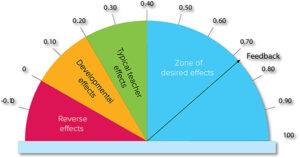Researcher John Hattie is one of my new heroes. His book Visible Learning: A Synthesis of Over 800 Meta-Analyses Relating to Achievement has really opened my eyes to the changes that we need to be making in our classrooms. In his meta study, Hattie compared the effect sizes of aspects that influence learning outcomes, pointing out that in education most things work. The question is which ones work best and where to concentrate our efforts. In other words, what changes accelerate student learning the most?
(Side note: To fully understand Hattie’s research, we have to understand that “effect size” is simply a way of quantifying the size of the difference between two results in a study. Cohen suggested that an effect size of 0.2 be considered a “small” effect, an effect size of 0.5 represents a “medium” effect, and 0.8 a “large” effect size. So we would want to see an effect size of 0.5 or higher as a gauge of what changes to make. The graphic below explains it well. Source)

I’ve taken the liberty of picking five of Hattie’s top ten influences on achievement and examining them in terms of how technology might help us better use them for learning. Here’s what I discovered.
Self-Reported Grades/Student Expectations (1.44 effect size)
This had the biggest influence on achievement out of all of the ones that Hattie looked at. Students set their own goals, monitor their own achievement, and reflect upon their process of learning. The strategy “involves the teacher finding out what are the student’s expectations and pushing the learner to exceed these expectations.” (Source) What technology could be used to help students better reflect on their own learning?
- Blogging
- Choice boards
- ePortfolios (Google Keep, for example)
- Flipgrid or VoiceThread reflections
- Seesaw
Teacher Credibility (.90 effect size)
Trust, competence, energy, enthusiasm, and consistency are among the top characteristics students consider when determining if their teacher is credible and if they are going to choose to learn from them. Hattie defines this as the teacher being highly organized when teaching, having a powerful speaking style, and removing barriers between himself and the student. While no technology today will help students trust a teacher more, technology can be used to stay organized. Google Calendar, OneNote, and other items can help the teacher manage the content that is to be taught. Thrively can be used to help the teacher learn about student strengths and interests, which can help to build trust between them.
Classroom Discussion (.82 effect size)
Hattie defines classroom discussion as “a method of teaching, that involves the entire class in a discussion. The teacher stops lecturing and students get together as a class to discuss an important issue.” You can find helpful tips to take your class discussions to the next level here.
There are several powerful technology tools that can facilitate classroom discussions, including Google Classroom, Today’s Meet, Flipgrid (with video comments by students), Skype, and Google Hangouts. The key with all of these technologies is that the students are doing the discussion while the teacher is facilitating the conversation.
Teacher Clarity (.75 effect size)
Learning targets are clear and articulated with success criteria. Students should be able to answer: What am I learning today? Why am I learning this? How will I know that I learned it? Technology resources that can help with this include:
- Blended learning
- Flipgrid
- Google Classroom
- LMS (Learning Management System)
Feedback (.75 effect size)
Just-in-time feedback identifies where the student is at, what the expectation is, and what actions they can take to close the gap. It is far more important that the feedback be about the task, the process used, and the self regulation level than simple praise which contains no learning information. And the most powerful level of feedback of all is that given from the student to the teacher. (Here’s an excellent infographic on the seven things to remember about feedback.)
There are a wide variety of formative assessment tools available to educators today, including Nearpod, Recap, Formative, Socrative, Kahoot!, Plickers, Padlet, and more. (You can find an exhaustive list here.) But there are ways other than a simple quiz for students to provide feedback about their own learning. Consider blogging, Today’s Meet, an online discussion with private comments to the teacher, and reflection journals.
I would love to see teachers in teams embrace one of these “top five” ways to accelerate student learning and practice its use over a semester. To help them in the process, they can use the top five themselves as they learn the strategy. What do you think?

